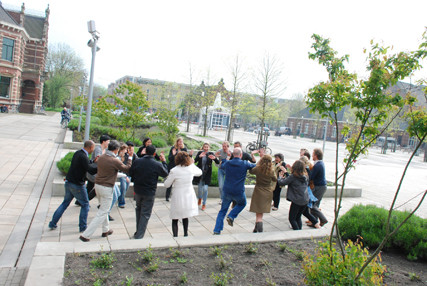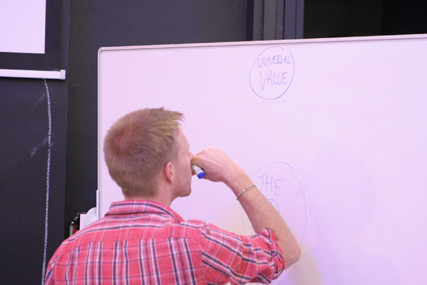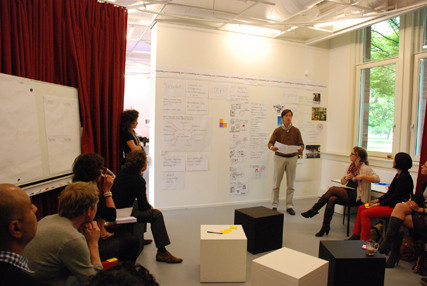 An improv comedy exercise to get the right brain working. (Photo courtesy of THNK: The Amsterdam School of Creative Leadership)
An improv comedy exercise to get the right brain working. (Photo courtesy of THNK: The Amsterdam School of Creative Leadership)
“What will a day in my life look like in 100 years?” I asked Anders Sandberg, an artificial intelligence expert from the (ironically named) Future of Humanity Institute at Oxford. Dr. Sandberg had just spent a couple of hours arguing eloquently about our future machine world—and how it’s a lot closer than you might think.
I expected that he would describe getting breakfast in the midst of robot companions, then going to the office in an unmanned vehicle, and so on. Instead, he shot back, “Well, what do we mean by ‘day’? I'm not sure there will be a ‘day’ and a ‘night’ that are different; maybe different parts of our mind will experience both simultaneously.” I just sat there, staring back at him, stupefied.
This conversation happened last month at THNK: The Amsterdam School for Creative Leadership, launched earlier this year to “develop the next generation of creative leaders that will have a significant societal impact in our world.” Partly funded by the city of Amsterdam, and influenced by the leadership thinking and creative modeling of companies such as McKinsey, Pixar, IDEO, and Phillips, THNK intentionally chose to stay outside of the formal education system so that it could create its own version of what leadership training for the 21st century should look like. For its first class, THNK selected 30 founding participants— accomplished individuals from around the world, with roughly equal proportions of social entrepreneurs, business intrapreneurs, and designers.
 Interactions with future-shapers. Here the group discusses "global migrations" with museum curator Wayne Modest. (Photo courtesy of THNK: The Amsterdam School of Creative Leadership)
Interactions with future-shapers. Here the group discusses "global migrations" with museum curator Wayne Modest. (Photo courtesy of THNK: The Amsterdam School of Creative Leadership)
But why “creative leadership”? Is this simply another dime-a-dozen, executive MBA leadership-training cash cow?
Are you enjoying this article? Read more like this, plus SSIR's full archive of content, when you subscribe.
No. Like so many present-day thought leaders, THNK believes that we are living in an era of accelerating change; that our technologies are moving our lives and bodies beyond our physical evolution’s capacity to keep up with the changes; that resources of all types are depleting faster than our political systems’ ability to address the losses; and that our education systems don’t help students prepare for these new realities. Its response is to fuse innovations from the business, nonprofit, and design worlds into a new way of creative problem-solving that, to paraphrase Einstein, gets us to a level of thinking that matches the problems we face.
Thus, when THNK calls itself a “school”, it means it's not just a place of learning, but also a “school of thought” (prioritizing creative leadership) and a “school of fish” (where a tribe of creative leaders inspire and learn from each other).
 Exploring the really big questions. (Photo courtesy of THNK: The Amsterdam School of Creative Leadership)
Exploring the really big questions. (Photo courtesy of THNK: The Amsterdam School of Creative Leadership)
How does it work? Central to nurturing creative leadership is generating inspiration from interactions with future-shapers, including Dr. Sandberg, Amazon.com CTO Werner Vogels, hacktivist and digital security expert Eleanor Saitta, serial entrepreneur Mark Randall, and former Greenpeace CEO Paul Gilding. Rumor has it that Pixar guru Michael Johnson will be at the next session. These meetings are explicitly designed as conversations, and faculty constantly urge us to challenge and provoke these experts. There are no lectures at THNK.
The rest of the structure is more “living lab” than classroom; through a number of challenges and exercises, we examine and develop our own leadership styles and journeys. For instance, through working on a large-scale problem/business opportunity for major clients (Vodafone, KLM, the city of Amsterdam itself), we experiment with the tools and techniques of the “creation flow” (a meld of the different ways entrepreneurs and creatives approach design). Through contrasting Socratic dialogue with improv comedy, or deciphering data versus building Lego models, we understand the value of harnessing both the left brain and right brain in answering a question. And through martial arts and other kinds of bodywork, we explore how to deal with opposing forces (whether external or internal), resist, and come back stronger.
 Presenting recommendations to Challenge partners KLM Airlines and the City of Amsterdam. (Photo courtesy of THNK: The Amsterdam School of Creative Leadership)
Presenting recommendations to Challenge partners KLM Airlines and the City of Amsterdam. (Photo courtesy of THNK: The Amsterdam School of Creative Leadership)
In addition to really big topics such as artificial intelligence, megacities, and sustainable living, there are smaller lessons that are worth their weight in gold. These include learning how Amazon.com structures its senior leadership meetings; the way a top-notch entrepreneur would hire their first team; the inside story of how Phillips beat Sony to the development of the CD; and how biomimicry shows us that in nature, the quickest way is not always the shortest way (think about how water flows in spirals, not straight, when you drain your bathtub).
There is no diploma or degree to certify what we are learning and how we are growing. Yet, with the focus on honest dialogue over lecture, the central role of personal coaching (I’m getting feedback from my coach and my peers that I’ve never received before), the emphasis on learning by doing, and the expectation that you will use this training to accelerate development of a personal vision and project (using whatever resources THNK has to share), I’m convinced that this is what higher education should look like.
Support SSIR’s coverage of cross-sector solutions to global challenges.
Help us further the reach of innovative ideas. Donate today.
Read more stories by Roshan Paul.

